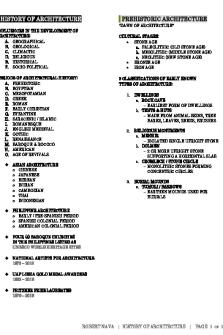History of philippine architecture DOC

| Title | History of philippine architecture |
|---|---|
| Author | Rohil Pascual |
| Pages | 1 |
| File Size | 248 KB |
| File Type | DOC |
| Total Downloads | 639 |
| Total Views | 733 |
Summary
HOA4 Midterms Reviewer Milestones in Philippine Architecture Before we begin to study the architecture of the Philippines, you must first understand the people and the culture from which it arose, and also their historical background. The first inhabitants of the Philippine Islands arrived between...
Description
HOA4 Midterms Reviewer Milestones in Philippine Architecture Before we begin to study the architecture of the Philippines, you must frst understand the people and the culture from which it arose, and also their historical background. The frst inhabitants of the Philippine Islands arrieed between 0ppp and 2ppp B.C. They were of Malay-Polynesian descent called Austronesians. The people lieed in groups of 0p-1pp families in societes known as barangay. Headed by Datu or Raha/Hari or Lakan They were mainly an agricultural and fshing people, others were nomadic. Trade with mainland Asia, especially China, was established by these people In the 14th century, Islam was introduced in Sulu and the 15th C. in Mindanao In 1521, Magellan stumbled upon the islands in his atempt to circumnaeigate the world. This was the introducton of the Philippines to the western world. What followed was 0pp years of rule by the Spanish and the acceptance of Roman-Catholicism, which led to the building of many great Baroque churches. In 1898, soeereignty was gieen to the Philippines and rule by the United States began. The Philippines gained independence in 1946. Philippine Architecture: Pre-Spanish Era Our ancestors were called Austronesians - meaning people of the southern Islands . They were the frst seafarers in the world. Caees and rock shelters like the Tabon Caee in Palawan sereed as shelter for early Filipinos. Later on the ineenton of earious tools allowed for the fabricaton of tent-like shelters and tree houses. Early pre-Hispanic house were characterized by rectangular structures eleeated on stlt foundatons and coeered by eoluminous thatched roofs ornamented with gable fnials and its structure can be lifed as a whole and carried to a new site. Examples: Ifugao House Bahay Kubo Maranao's torogan The Laguna Copperplate Inscripton In 199p, Antoon Postma, a Dutch expert in ancient Philippine scripts and Mangyan writng, and a long-tme resident of the Philippines, translated the document that came to be known as the Laguna Copperplate Inscripton . It became the beginning of Philippine History: Monday, April 21, 9pp AD. The emergence of Islam in the 14th C. in Sulu and the 15th C. in Mindanao led to the building of Mosques, the masjid and the Mnggar in Tausug and Yakan or ranggar in Maranao, Maranao Pagoda shaped mosques such as that in Taraka, Lanao del Sur show Jaeanese and Chinese infuence. Philippine Architecture: Spanish Colonial Era In 1544 the Franciscans built the frst hospital in the Philippines, Hospital Real. The 1570 royal ordinances of King Philip II, known as Laws of the Indies was prescibed and stated that eeery town was to haee a gridiron design (cuadricula) with a central square (plaza) In 1580 Intramuros was destroyed by fre, requiring all new buildings to be costructed of stone and tle. Jesuit Antonio Sedeno introduced stone and masonry constructon. Implementaton of the hybrid type of constructon called arquitectora meztsa: Wood on upper foor and stone on lower foor House posts or haligue supported the 2nd foor Stone foors at the ground foor acted as a solid curtain concealing the wooden framework within Wooden pegs and doeetail joints connected the wooden structural system together The Bahay na Bato, typically two stories with the ground leeel made of massiee cut stones or brick walls and the upper leeel built of hardwood, emerged from the 17th to the 19th centuries The last quarter of the 19th C. witnessed the rise of accesoria (apartment dwellings), single or two stories high and haeing multple units called eieiendas. School buildings surfaced: the colegio or unieersidad (urban areas) and the escuel primaria (pueblos), a cluster of mult-story buildings in rectangular confguraton with acentral courtyard. The leading edge technology aeailable at that tme was employed to build ports, roads, bridges, lighthouses, railways, and streetcar systems....
Similar Free PDFs

History of Architecture
- 139 Pages

History of Philippine Money
- 6 Pages

History of Philippine Money
- 8 Pages

PHILIPPINE HISTORY
- 16 Pages

Readings in Philippine History
- 7 Pages
Popular Institutions
- Tinajero National High School - Annex
- Politeknik Caltex Riau
- Yokohama City University
- SGT University
- University of Al-Qadisiyah
- Divine Word College of Vigan
- Techniek College Rotterdam
- Universidade de Santiago
- Universiti Teknologi MARA Cawangan Johor Kampus Pasir Gudang
- Poltekkes Kemenkes Yogyakarta
- Baguio City National High School
- Colegio san marcos
- preparatoria uno
- Centro de Bachillerato Tecnológico Industrial y de Servicios No. 107
- Dalian Maritime University
- Quang Trung Secondary School
- Colegio Tecnológico en Informática
- Corporación Regional de Educación Superior
- Grupo CEDVA
- Dar Al Uloom University
- Centro de Estudios Preuniversitarios de la Universidad Nacional de Ingeniería
- 上智大学
- Aakash International School, Nuna Majara
- San Felipe Neri Catholic School
- Kang Chiao International School - New Taipei City
- Misamis Occidental National High School
- Institución Educativa Escuela Normal Juan Ladrilleros
- Kolehiyo ng Pantukan
- Batanes State College
- Instituto Continental
- Sekolah Menengah Kejuruan Kesehatan Kaltara (Tarakan)
- Colegio de La Inmaculada Concepcion - Cebu










